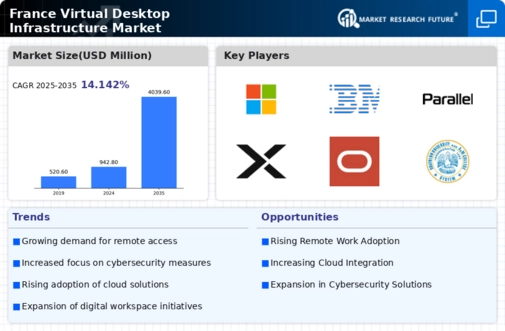Rising Focus on Cost Efficiency
Cost efficiency remains a critical driver for the virtual desktop-infrastructure market in France. Organizations are increasingly seeking ways to reduce IT expenditures while maintaining high levels of service delivery. By adopting virtual desktop solutions, companies can minimize hardware costs, as they rely on centralized resources rather than individual devices. Reports indicate that businesses can save up to 30% on IT costs by transitioning to virtual desktop environments. This financial incentive is compelling for many French enterprises, particularly small and medium-sized businesses, which often operate with tighter budgets. Consequently, the virtual desktop-infrastructure market is likely to see sustained growth as organizations prioritize cost-effective solutions that do not compromise on performance.
Shift Towards Hybrid IT Environments
The shift towards hybrid IT environments is a significant driver for the virtual desktop-infrastructure market in France. Organizations are increasingly adopting a combination of on-premises and cloud-based solutions to optimize their IT operations. This hybrid approach allows businesses to maintain control over sensitive data while benefiting from the scalability and flexibility offered by cloud services. As a result, the demand for virtual desktop solutions that seamlessly integrate with both environments is on the rise. The virtual desktop-infrastructure market is likely to thrive as companies seek solutions that facilitate this hybrid model, enabling them to adapt to changing business needs while ensuring operational continuity.
Growing Demand for Remote Work Solutions
The virtual desktop-infrastructure market in France is experiencing a notable surge in demand for remote work solutions. As organizations increasingly adopt flexible work arrangements, the need for secure and efficient remote access to desktop environments has become paramount. According to recent data, approximately 60% of French companies have implemented remote work policies, driving the necessity for virtual desktop solutions. This trend is likely to continue, as businesses recognize the benefits of maintaining productivity while allowing employees to work from various locations. The virtual desktop-infrastructure market is thus positioned to capitalize on this growing demand, providing solutions that enhance collaboration and streamline workflows, ultimately contributing to improved operational efficiency.
Increased Regulatory Compliance Requirements
The virtual desktop-infrastructure market in France is significantly influenced by the increasing regulatory compliance requirements across various sectors. Organizations are mandated to adhere to stringent data protection laws, such as the General Data Protection Regulation (GDPR), which necessitates robust security measures for handling sensitive information. As a result, businesses are turning to virtual desktop solutions that offer enhanced security features and centralized management capabilities. This shift not only aids in compliance but also mitigates risks associated with data breaches. The virtual desktop-infrastructure market is thus likely to expand as companies invest in solutions that ensure compliance while safeguarding their data assets.
Technological Advancements in Virtualization
Technological advancements in virtualization are propelling the virtual desktop-infrastructure market in France. Innovations such as improved graphics processing capabilities and enhanced user experience features are making virtual desktops more appealing to organizations. The integration of artificial intelligence and machine learning into virtualization technologies is also streamlining operations and optimizing resource allocation. As these technologies evolve, they are expected to enhance the performance and reliability of virtual desktop solutions. This trend suggests that the virtual desktop-infrastructure market will continue to grow, as businesses seek to leverage cutting-edge technologies to improve their IT infrastructure and user satisfaction.





















Leave a Comment